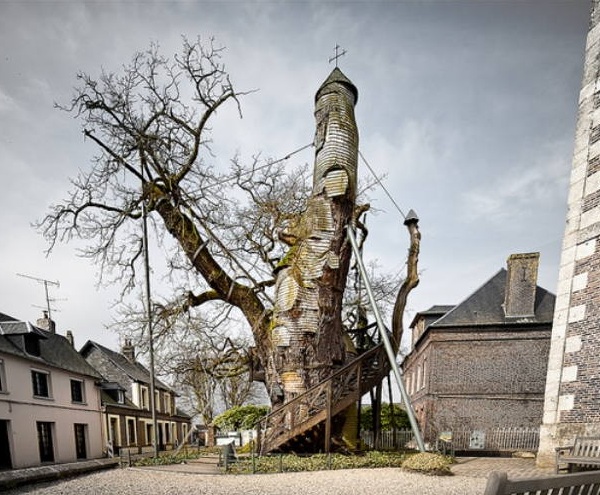Courtesy of All That Is Interesting, we find a fascinating series of photographs of the Chêne chapelle (meaning ‘chapel oak’). The Web site reports:
Located in the French farming village of Allouville-Bellefosse, this amazing oak tree is home to more than just woodland flora and fauna: its hollow, thousand-year-old trunk serves as the base for two small chapels accessible via spiral staircases that surround the tree.
This oak tree is the oldest known tree in France and many locals speculate that it actually dates back to … Charlemagne’s reign in the eighth century.
Despite its bevy of functions today, the oak tree wasn’t converted into a space for two chapels until the 1600s when it was struck by lightning. A true blessing in disguise, the lightning strike hollowed out the trunk and soon the charred tree drew the attention of Abbot Du Détroit and village priest Du Cerceau. Soon, the clerics deemed it a miraculous tree and thus decided to build a shrine to the Virgin Mary in the hollow. The adjoining staircases came in later years.During the French Revolution, the Oak Chapel was vulnerable to the throngs of protesters who abhorred the old ways of the church. Adamant in their desires to burn the tree down, the protesters … only ceased their campaigning after a local renamed the tree the “Temple of Reason.”
There’s more at the link, including many more (and larger) photographs.
What amazes me is that the tree survived the Allied invasion of France in 1944. The village is in Normandy, where the landings took place, and combat must have raged nearby for several weeks. It seems almost miraculous that something like the tree chapel could have survived intact, particularly because a tall ‘structure’ like that would make a logical place to hide a sniper or artillery observer. An enemy, suspecting that, would be inclined to destroy it rather than risk its being used for such purposes – as happened, for example, to the Benedictine Abbey at Monte Cassino in Italy.
Peter
